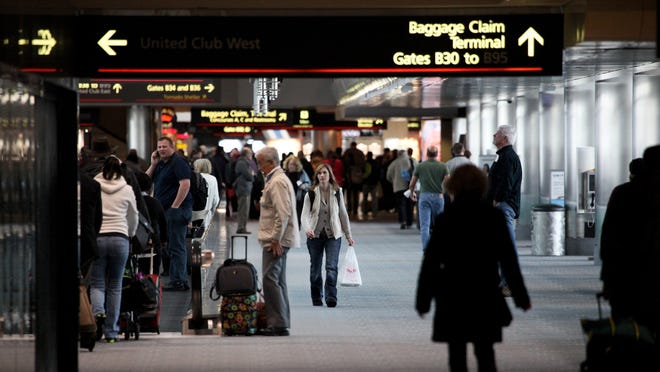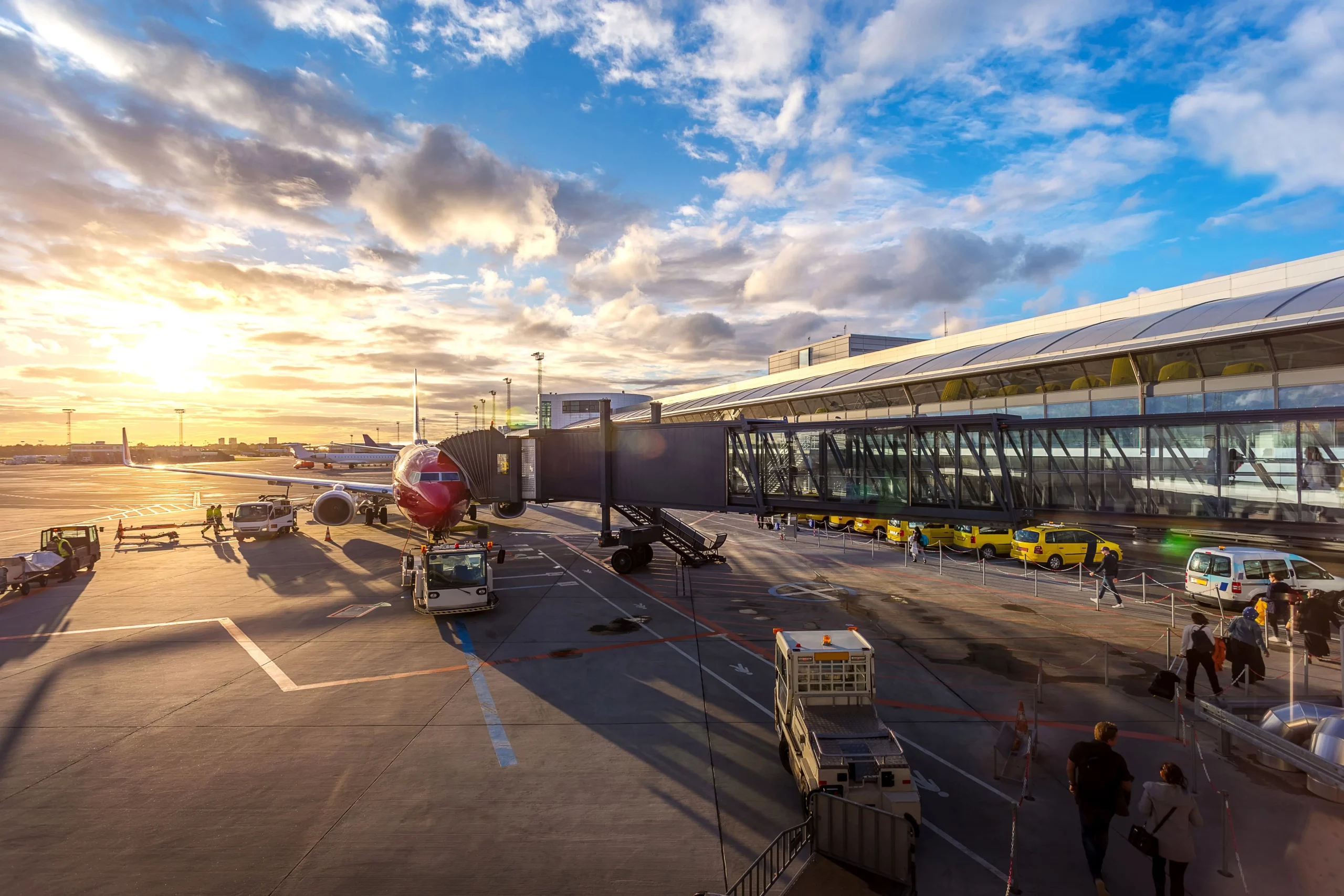An image of a cityscape is depicted in this photo. The skyline is visible, as well as various tall buildings, all of which appear to be illuminated in the night. The sky is dotted with stars, making it a stunning sight to behold.
When you are flying to destinations other than two big airports, you will probably have to switch planes. This “hub and spoke” system used by the major airlines is based on the idea that they will provide flights from most cities, apart from their busiest locations.
When traveling from any location to any other destination, connecting flights offer a one-stop service. However, there is always a risk of missing the connection. To minimize this chance, follow these tips:
Be aware of the least amount of time necessary to connect flights at your particular airport.
When acquiring flights that require connecting, airlines have established minimum times for transfers at their hubs. If the booking is done in one itinerary, either on the airline’s website or through a travel agency, the airline’s system will adjust the duration of the layover to meet their standards. If the passenger is unable to catch their next flight due to the set time, the airline is obligated to provide them with the next available flight without any additional cost.
Various airlines list their own connecting times on their websites. These minimal connecting times can be incredibly brief at major airports, with some even as short as thirty minutes. Domestic-to-domestic connections are usually less than an hour, while international connections are normally more than one hour and can exceed two hours in airports with separate international and domestic terminals. Certain airlines add additional time for connections including jumbo jets.
Although most airline postings do not feature connecting times between different carriers, the International Air Transport Association (IATA) compiles detailed data regarding this matter. However, this information is not available to the public. The OAG (Official Airline Guide), Skyguide, and the Global Distribution Systems (GDS) used by travel agents do show connecting times, but only for subscribers.
If you don’t make use of a travel agent or pay for a service, you won’t be able to find the information you’re looking for. I haven’t been able to locate a comprehensive online listing of IATA connecting times that don’t necessitate payment. Furthermore, airlines usually publish minimum times which are shorter than IATA times.
When you book a single ticket for a trip with multiple connections, the booking system will automatically take into account the connecting times that apply. This is the case even when the ticket includes flights on two different airlines that have interline agreements. Typically, these tickets will provide for the checking of baggage from the starting point to the final destination, including during transfers.
I recently heard from a weary voyager that encountered an issue, even with a solitary ticket. A ground agent declined to check her sack from Europe to the U.S., asserting that her carrier checked through bags just when it was linked to another airline in the same coalition. To my knowledge, this is an unusual incident, which is likely the outcome of bad preparation as opposed to an awful customer policy.
Remaining loyal to one airline or alliance when making a connection is recommended.
Where feasible, it is recommended to book connecting flights with a single carrier or air carriers that are members of an alliance. Generally, at main hub airports, airlines try to ensure their gates and partner gates are in close proximity. If not, they supply internal-security transportation services or shuttles to any gates they use.
Despite possessing an authentic interline ticket, certain huge hub airports necessitate travelers to depart security at one terminal and re-enter at another in order to make a connection. In addition, a few airports have one airline that utilizes two different terminals. Therefore, airlines should factor in the required time for going through different terminals when creating the itinerary.
It is best to avoid booking two separate tickets when you are looking to take connecting flights.
It is best to avoid purchasing two tickets, one from each airline, if at all possible. When the connection time between flights is short, there is no guarantee that the second airline will wait for you if the first flight is delayed. Furthermore, they can cancel your reservation and you will need to buy a new ticket for the next available flight. In some cases, you may be able to get on the next plane without any additional fees, but this is not always the case.
If you purchase a ticket that involves two airlines, you will usually have to drop off your luggage at the initial connection point of the first airline, then go through the security checkpoint, collect your items, take them to the counter of the second airline and check them in again, followed by another security screening. Make sure to leave plenty of extra time for this procedure.
Sometimes, it is possible to have tickets on the same airline even if they are purchased separately. For instance, if you buy a flight to a nearby hub to connect to an award ticket. Whether you can have your checked baggage and yourself go directly to your destination is uncertain: Certain agents are accommodating while others are not.
Filling up your day-to-day routine
It is the airline’s responsibility to provide you with the next available flight if you miss a connection on a single ticket. However, this may not always be an adequate solution due to the availability of seats.
Stepping out of an airplane and having to scurry across a large airport to a far away departure gate can quickly reduce a 30-minute connecting time to nothing. This is why lots of vacationers plan ahead and factor in a more lengthy layover than the minimum during a hub. Generally, airlines grant travelers four or more hours of maximum layover time. A longer stayover is possible if the airline runs multiple flights for both parts of the journey. But if the only available itinerary necessitates a tight connection, it can become a nail-biting experience.
It is recommended to provide a generous amount of leeway when you are traveling with two tickets. My personal rule of thumb is to allow a minimum of three hours. A four-hour window is even more preferable.
Steer clear of the final link
For decades, travelers have been warned not to book the final flight of the day from a connecting airport. This is because, in the event of a delay, the airline would need to arrange the next flight the following day, resulting in the passenger having an unexpected overnight stay at the connecting hub.
It follows logically that one should make reservations as soon as possible in the day in order to maximize the likelihood of arriving on the intended date. The more times of departure available, the greater the chances of achieving the desired outcome.
Selecting the most appropriate hub for your connection is essential.
When selecting your airport, it is possible to avoid some stress-inducing delays by avoiding those hubs that have been historically more likely to be delayed. Data currently shows that the five worst major airports in the United States for delays are Chicago O’Hare, Dallas/Fort Worth, New York JFK, Newark, and San Francisco. On the other hand, the airports located in the Sunbelt region typically have fewer delays.
If you’re traveling with multiple airlines, it’s best to stay away from U.S. hub airports with multiple terminals that don’t have internal security control or any “airside” people mover system. The most difficult to navigate through in this regard would be airports in Boston, Chicago O’Hare, Los Angeles, and New York JFK.
Almost everyone who travels in Europe prefers to avoid hubs like London Heathrow, Paris De Gaulle, and Frankfurt. Amsterdam (Sky Team) and Munich (Star Alliance) are particularly popular, and Brussels, Copenhagen, Helsinki, Madrid, Rome, and Zurich, are also seen as desirable secondary hubs.
Think of a strategy for packing your bags for the connecting flight.
When it comes to managing your luggage during a connecting flight, there is no universal “correct” solution. Checking your bags may lead to them being lost or not arriving in time for your next flight, while lugging a wheeled carry-on from one end of a large terminal to the other may slow you down and make you exhausted. Ultimately, you must determine which route is best for you.
It is important to choose your seat on the aircraft carefully if you have a short time between flights.
If you’re able to, try to secure a seat near the front of the plane when you’re on your maiden flight. It’s worth spending a bit extra if it means you’ll be sitting by the exit door, as it can potentially reduce your time of disembarking by 5-10 minutes.
For assistance with the connection process, GateGuru, Weatherbug, and AirportMaps are apps that can be downloaded. GateGuru provides information on departure gates, Weatherbug furnishes the weather at a connecting hub, and AirportMaps details places to grab a bite to eat in the terminal.
In the event you find yourself having to stay at a connecting airport, HotelTonight has the means to help you find a place to sleep. It’s recommended that you also have your airline’s app on hand.
It is still beneficial to take direct flights instead of connecting ones.
When it comes to avoiding connection issues, opting for a non-stop or direct flight is the most reliable method. Bear in mind that when one chooses a connecting itinerary, there is a minimum of two hours added to the overall trip time, and more often than not, it is three. Therefore, sometimes it is worth traveling up to 200 miles from/to a different airport to take a non-stop flight. It has been noted that when it comes to O’Hare airport, the best solution is to fly over it at 30,000 feet.
Find out which airports have the longest distances between gates:

This image shows the Concourse B of Denver Airport. It has a width of 660 and a height of 372, and its format is pjpg. It is an auto-webp.
The utilization of technology is becoming increasingly widespread in the classroom. Schools are recognizing the value of technology as an educational tool and are increasingly incorporating it into their curriculums. As a result, students are leveraging the advantages of these tools to facilitate learning and to gain a better understanding of the topics.
